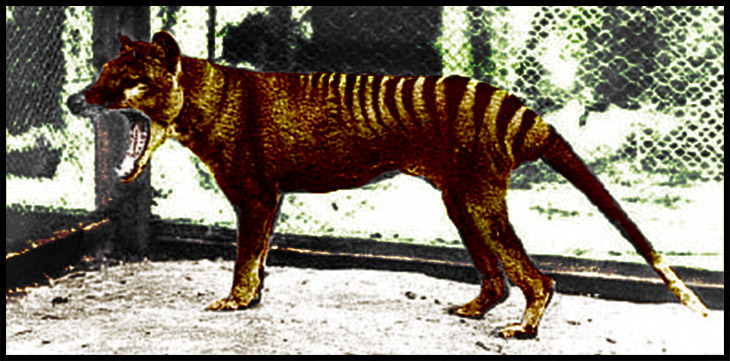Why Did Tasmanian Tiger Go Extinct
Human intervention is by. The government even offered bounties for hunting Tasmanian wolves.

Tasmanian Tigers Are Extinct But Why Do People Keep Seeing Them Deccan Herald
Tasmanian tigers go extinct due to hunting for their skin and fur and lost of habitat due to deforestation.

Why did tasmanian tiger go extinct. On 7 September 1936 only two months after the species was granted protected status Benjamin the last known thylacine died from exposure at the Beaumaris Zoo in Hobart. The Tasmanian tiger is still extinct. The Thylacine became extinct on the Australian mainland not less than 2000 years ago.
The government bounty may seem to be the obvious extinction culprit. The Tasmanian tiger-wolf became extinct on the mainland of Australia long ago because it could not compete for food with an introduced species the dingo a kind of wild dog. The thylacine also known as the Tasmanian tiger was a carnivorous marsupial whose resemblance to a wolf made it among the most distinct fauna of Australia.
A sudden decline in the thylacine population was reported in the early 1900s and the species was declared extinct in 1936. Specifically the authorities were unable to appreciate what a remarkable creature it was and so they put. However excessive hunting combined with factors such as habitat destruction and introduced disease led to.
While it is estimated there were around 5000 thylacines in Tasmania at the time of European settlement. August 18 2020 840pm EDT. But growing scientific evidence reveals a complex tapestry of forces involved in their decline.
While it is estimated there were around 5000 thylacines in Tasmania at the time of European settlement. Tasmanian tiger-wolves continued to thrive on the dingo-free island of Tasmania off Australias south coast until Europeans arrived in the region. Until it was hunted to extinction the thylacine.
Between 1888 to 1908 over 2000 Tasmanian wolves were killed in hunts. In some ways it seems to represent the sadness associated with the treatment of the Tasmanian Aborigines and the inhumanity inflicted on Convicts. Tasmania had few people and no dingoes though so it became a last refuge to the Tasmanian tiger and its close cousin the Tasmanian devil.
The government bounty may. Watch out a lot more about it. The Thylacine Thylacinus cynocephalus also known as the Tasmanian Tiger and sometimes the Tasmanian Wolf became extinct during the 20th century.
Australias colonization brought about the erosion of the thylacines habitat. The Smilodon the proper name for the species is part of the Falidae family that includes all cats both living and extinct. Known officially to science as a thylacine the.
However excessive hunting combined with factors such as habitat destruction and introduced disease led to the rapid extinction of the species. Its decline and extinction in Tasmania was probably hastened by the introduction of dogs but appears mainly due to direct human persecution as an alleged pest. In fact the Tasmanian tiger became extinct in 1936.
Threats to Tasmanian devils include attacks by domestic dogs and foxes being hit by cars loss of habitat and disease. They are the only subspecies of tigers to have a different body shape and a long snout. The last Tasmanian tiger died in Beaumaris Zoo Tasmania.
The Tasmanian tiger was hunted to extinction as a large predator but it was only half as heavy as we thought. Scientists believe that Tasmanian tigers were hunted and killed by humans and dingoes which ultimately led to the Tasmanian tigers demise in those areas. A little over 50 years later the Tasmanian tiger was officially declared extinct.
The Tasmanian tiger a striped marsupial carnivore was thought to have gone extinct after Benjamin believed to be the last member of the species died. By the 1920s sightings of the Tasmanian tiger in the wild became extremely rare and in 1930 a farmer from Mawbanna named Wilfred Wilf Batty shot and killed the last-known wild Tasmanian tiger. Tasmanian tiger skeletons on display at Tasmanian Museum and Art Gallery Hobart However it is likely that multiple factors led to its decline and eventual extinction including competition with wild dogs introduced by European settlers 100 erosion of its habitat the concurrent extinction of prey species and a distemper -like disease that affected many captive specimens at the time.
Reports of its enduring survival are greatly exaggerated. Its sad that they died out. The first is that climate change specifically the sudden increase in ENSO activity around 4000-6000 years ago may.
Despite its size weighing in at around five feet long and 440 lbs and its two seven-inch canine teeth environmental change lack of food and human hunting saw this fascinating beast die off from the face of the Earth. However it allegedly preyed on a variety of livestock prompting European settlers to hunt the species to extinction. Adding to their eventual extinction.
Though scientific research claimed that the major livestock killer during that era was actually wild dogs Tasmanian wolves were still blamed and became the scapegoat for the dogs during that time. Various explanations and research findings aim to explain its extinction with the three main theories being human intervention competition and climate change. As for what caused the extinction of these two animals scientists are still unsure however Jeremy says that there are three main theories.
A sudden decline in the thylacine population was reported in the early 1900s and the species was declared extinct in 1936. The largest predator in the devils ecosystem is the Tasmanian wedge-tailed eagle which competes for food with scavenging devils. The last known specimen died in the Hobart Zoo.

What Happened To The Tasmanian Tiger
0 Response to "Why Did Tasmanian Tiger Go Extinct"
Post a Comment